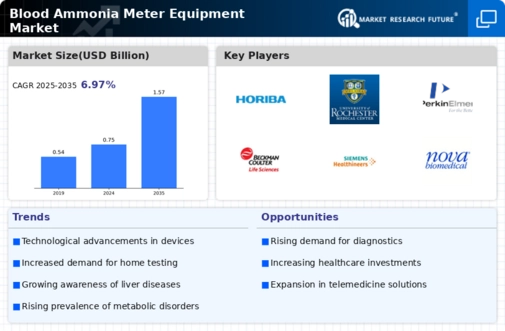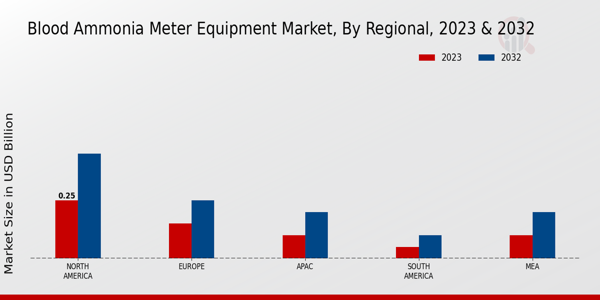Market Growth Projections
The Global Blood Ammonia Meter Equipment Market Industry is projected to experience substantial growth over the next decade. With a market value of 0.75 USD Billion in 2024, it is anticipated to reach 1.57 USD Billion by 2035, reflecting a compound annual growth rate of 6.96% from 2025 to 2035. This growth is driven by various factors, including the rising prevalence of liver diseases, technological advancements, and increased healthcare expenditure. The market's expansion indicates a growing recognition of the importance of accurate ammonia level monitoring in clinical settings, thereby enhancing patient care and outcomes.
Increased Healthcare Expenditure
Rising healthcare expenditure across various regions is a crucial driver for the Global Blood Ammonia Meter Equipment Market Industry. Governments and private sectors are investing significantly in healthcare infrastructure, which includes diagnostic equipment. This increased funding allows for the procurement of advanced blood ammonia meters, enhancing diagnostic capabilities in hospitals and clinics. As healthcare systems evolve, the emphasis on early diagnosis and preventive care becomes paramount. The market's growth, from 0.75 USD Billion in 2024 to an estimated 1.57 USD Billion by 2035, reflects the positive correlation between healthcare investment and the demand for innovative diagnostic tools.
Rising Prevalence of Liver Diseases
The increasing incidence of liver diseases globally drives the demand for blood ammonia meter equipment. Conditions such as hepatic encephalopathy necessitate accurate ammonia level monitoring, which is crucial for patient management. The Global Blood Ammonia Meter Equipment Market Industry is witnessing a surge in demand as healthcare providers prioritize early detection and treatment. In 2024, the market is valued at 0.75 USD Billion, reflecting the urgent need for effective diagnostic tools. As awareness of liver health grows, the market is expected to expand, with projections indicating a value of 1.57 USD Billion by 2035, showcasing a compound annual growth rate of 6.96% from 2025 to 2035.
Growing Demand for Home Healthcare Solutions
The shift towards home healthcare solutions is significantly influencing the Global Blood Ammonia Meter Equipment Market Industry. Patients with chronic liver conditions increasingly prefer monitoring their ammonia levels at home, which necessitates the availability of user-friendly and reliable devices. This trend is further supported by the aging population, which often requires ongoing health management. As a result, manufacturers are focusing on developing portable and easy-to-use blood ammonia meters. The market's growth trajectory, projected to reach 1.57 USD Billion by 2035, indicates a robust response to this demand, with a CAGR of 6.96% from 2025 to 2035.
Regulatory Support for Diagnostic Innovations
Regulatory bodies are increasingly supporting the development and approval of innovative diagnostic tools, including blood ammonia meters, which positively impacts the Global Blood Ammonia Meter Equipment Market Industry. Streamlined approval processes and incentives for manufacturers encourage the introduction of advanced technologies that improve patient care. This regulatory environment fosters innovation and ensures that healthcare providers have access to the latest diagnostic solutions. As a result, the market is expected to grow significantly, with projections indicating a rise from 0.75 USD Billion in 2024 to 1.57 USD Billion by 2035, driven by these supportive regulatory frameworks.
Technological Advancements in Diagnostic Tools
Technological innovations in blood ammonia meters enhance their accuracy, speed, and ease of use, thereby propelling the Global Blood Ammonia Meter Equipment Market Industry forward. Advanced features such as point-of-care testing and integration with electronic health records improve clinical workflows and patient outcomes. These developments not only streamline the monitoring process but also facilitate timely interventions in critical care settings. As healthcare systems increasingly adopt these sophisticated devices, the market is poised for growth. The anticipated rise in market value from 0.75 USD Billion in 2024 to 1.57 USD Billion by 2035 underscores the impact of these advancements on the industry.











